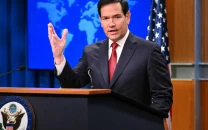Pakistan in a bind
Getting the country out of it will require political will, which those who hold the reins of power seem to lack.

Now, with decades of experience behind them, economists have begun to recognise that they must go beyond the boundaries of their discipline to understand how economies succeed and fail. The number of factors contributing to growth continues to increase as more empirical work is underway in intuitions such as the World Bank that now has large amounts of economic, social, political and demographic data at hand to understand the relationships between the many different attributes of any society. This applies to both, developed and developing nations. The latter group is now euphemistically called ‘emerging nations’.
It is safe to assume in the case of a country such as Pakistan that politics and international relations will profoundly affect the structure of the economy and the rate of its expansion. Both in turn will have enormous social consequences. One of the disturbing things about the way the country’s economy has been managed has to do with the lack of attention given to statistics and the availability of information. The size and rate of increase in the country’s population are two important pieces of information that are critical for undertaking economic planning. There is other population related information that is needed. For instance: what is the gender division of the population, what is the rate of increase in the number of people living in large cities and towns, what is the rate at which people are leaving the countryside and moving to the urban areas, what is the size of the work force, how many women are now working and how many of them are working outside their homes? It is from population censuses that such information is obtained but Pakistan, mostly for political reasons, finds it hard to systemically count the people and collect information about their social and economic circumstances. A household survey was conducted which was to be followed by a population census. The latter has not taken place. In the absence of this information we have to proceed on the basis of guess work.
In mid-2012, the population of Pakistan stands at some 190 million. The median age is 21 years, one of the lowest of all major population groups in the world. This means that some 95 million people are below that age. The current rate of increase in population is adding close to four million people a year. Given the fact that the rate of population increase in the past was a little higher, the work force is increasing at rate of three per cent a year. This rate could be even higher if more women begin to look for work outside their homes.
Some of the analysts who have worked in this area of economics believe that employment elasticity in Pakistan is a bit more than 0.5, which means that for every percentage point increase in GDP, employment grows by half a percentage point. Based on this estimate, the GDP must increase by six per cent a year for the pool of the unemployed not to increase in size. The rate has to be higher than this in order to shrink the size of the pool of the unemployed.
With the rate of GDP not likely to be much more than 2.5-3 per cent a year for the next few years, Pakistan can count on social turbulence. What form it will take is hard to predict. The democratic system under development gives an outlet to those not being helped by the economy. The Benazir Income Support Fund which is believed to be reasonably well-managed and is said to be free of the types of leakages that are common for such programmes also helps in keeping the frustrations of the very poor for being articulated in violent ways. Pakistan will probably not see the kind of Arab Spring that shook the Middle East. What could happen though is that the unemployed youth may get attracted to extremist causes which pick up their recruits from among those who don’t see much of a future for themselves. For social peace, therefore, it is important that the Pakistani state works hard to increase the rate of economic expansion. But here politics and international relations are proving to be hindering forces.
For the rate of growth to increase, Pakistan must invest a larger proportion of its income, particularly in the areas in which the state must be involved. This means the ability to raise more resources by improving tax collection and bringing more people and sectors into the tax base. This has been hard to do. There are important political constituencies that won’t allow these changes to take place. In order to meet the resource gap, Pakistan could turn to the outside world but this has turned increasingly hostile. The country is, therefore, in a bind. Getting out of it will require political will, which those who hold the reins of power seem to lack.
Published in The Express Tribune, June 18th, 2012.















COMMENTS
Comments are moderated and generally will be posted if they are on-topic and not abusive.
For more information, please see our Comments FAQ